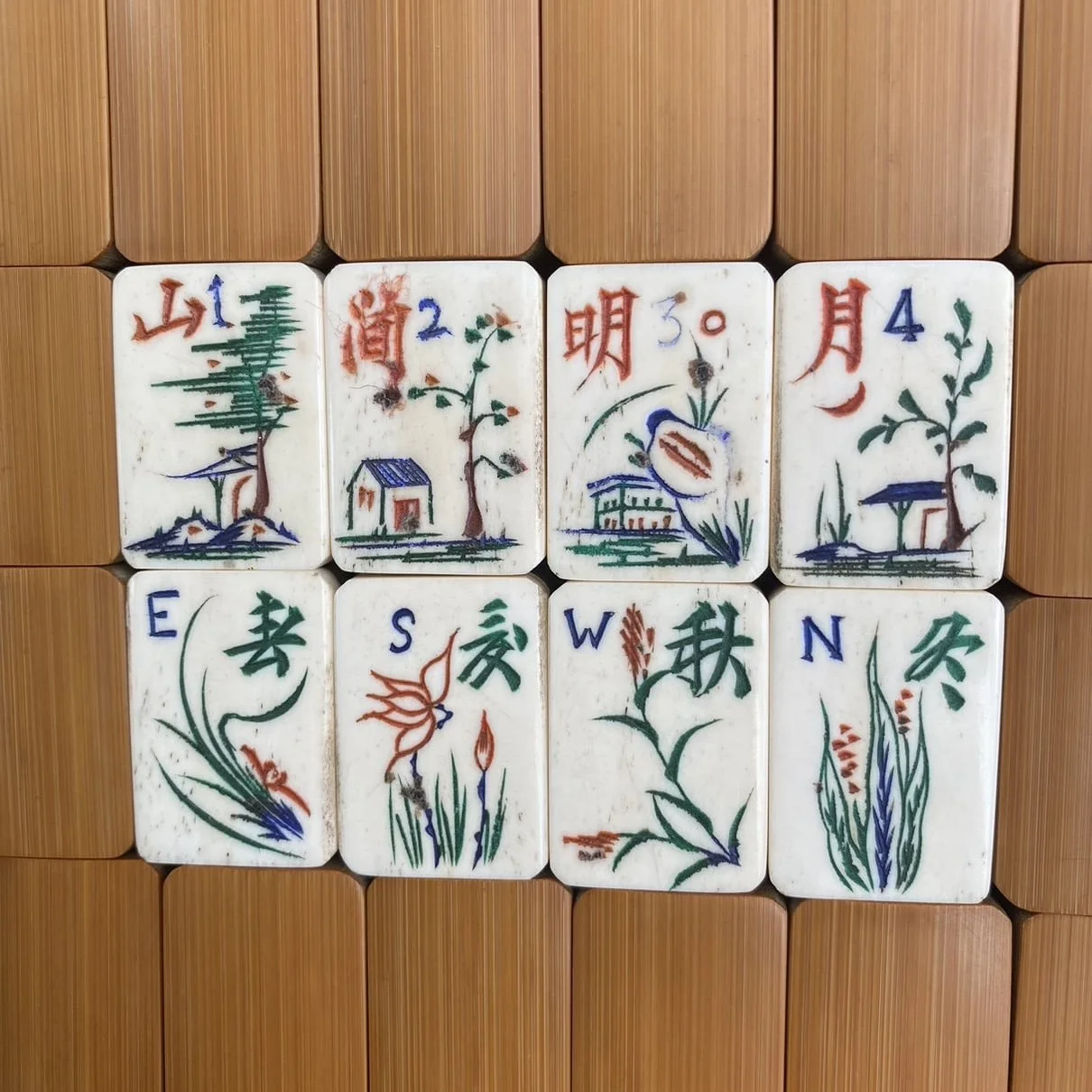Things aren’t always as they appear
I don’t read Chinese (beyond a standard mahjong set that is), but I regularly play mahjong with people who do. It was this that raised some issues about the assumptions I have made about the meaning of characters that appear on ‘flower and season’ tiles.
Last weekend I was playing with a vintage set that came in an unprepossessing leather box with five trays inside. All the usual tiles were there to make up the 144 tiles, together with 3 bone dice and a pile of bone scoring sticks. The box has no branding and the rule book, bound with the same leather as the box, was in English but also with no indication of who produced the set or when.
I would, however, date it as 1930’s or 1940’s, produced in China for the British market. Beautifully carved on 25% bone to bamboo tiles, the ‘flower and season’ tiles bore unconventional images with both a character and romanised letters or numbers in red and blue. The bone itself was very creamy, with a fine patina and the appearance of imported bleached bone, rather than the more natural looking bone found on many sets made for the domestic market.
We all know that ‘flower and season’ tiles of this vintage don’t necessarily have characters that simply name the usual 4 flowers (plum, orchid or lily, chrysanthemum, bamboo) and the 4 seasons, and these tiles had characters that I felt were unusual. Also, unusually in my collection, 4 of the 8 tiles were labelled with the romanised letters E, S, W and N rather than the more frequently found 1, 2, 3, 4 in two colours to distinguish ‘flowers’ from ‘seasons.’
As I was playing with people who could read Chinese I raised the question of what the characters said, and got a curious response. The ‘season’ tiles with W and N in the corners were straightforward as the characters meant ‘autumn’ and ‘winter’ respectively. I then assumed that the E and S labelled tiles must be ‘spring’ and ‘summer,’ but was surprisingly told that these 2 tiles had characters that were not Chinese at all, but perhaps Japanese.
The 4 ‘flower’ tiles did not bear the names of flowers but 4 characters that may make a 4-character idiom, although one tile, the one carrying the number 2 proved difficult to read as its top was smudged. The best guess was that it translated to either ‘room or space’ (jian) or ‘simple, in the sense of uncomplicated’ (jian). The other 3 tiles translated to (1) mountain (shan), (3) bright (as in sun)(ming), and (4) moon (yue). The sun and moon tiles had also been carved with a tiny sun and a tiny moon next to each character. The combination of sun and moon is not unusual in Chinese idioms, as together they convey eternity and their beauty is often seen as enhanced against the mountain landscape. The character on the 3 tile (ming) is actually composed of both a sun radical and the character for moon, reinforcing the feeling of eternity in the phrase ‘bright moon.’
Piqued by curiosity for the ‘none-Chinese’ characters one of my translating players contacted a friend who reads Japanese to see if he could confirm the characters on the E and S tiles. Sure enough, they are the Japanese characters for Spring and Summer. Two Asian languages represented on one set! Maybe one workshop was making sets for both the British and Japanese markets and a mistake was made.
The book included with the set makes specific reference to the possibility of confusion within the carvings of the ‘flower and season’ tiles. It warns “The Seasons are marked with with Chinese characters in RED and the Flowers in GREEN. The designs on these pieces vary in different sets, and attention should, therefore, only be paid to the numbers and colour.” Guidance very hard to follow!





